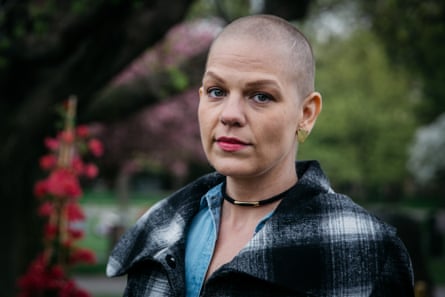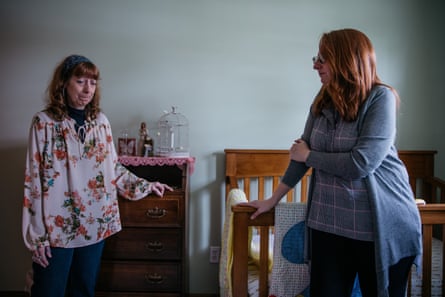The first time Kate Plants almost lost her fertility was in May, 2015, after learning she had ovarian cancer.
Thank God I still have a uterus, she thought, when her left ovary had to be removed. Kate and her husband, Jeremy, had been trying to conceive when she was diagnosed. Thank God I can still get pregnant.
The second time Kate Plants almost lost her fertility was in February, 2017, when doctors informed her she had uterine cancer. At the clinic that day, the look of horror on her mother-in-law’s face said it all: this was bad; Kate was in trouble.
Driving home, Kate and Jeremy were crying so hard they had to pull over. Three months later, doctors removed her uterus. Thank God we still have our embryos, she thought after the hysterectomy – the couple had frozen five before Kate underwent surgery.
For the second time, doctors had saved her life. Kate had no chance of ever becoming pregnant, but she was comforted by the fact that a gestational carrier could carry the baby created by one of the embryos she and Jeremy had safely stored.
Then, two months ago, the Plants were told the embryos, along with thousands of others, had been destroyed.
And with this news, Kate’s fertility was gone forever.

On May 12, a Mother’s Day weekend memorial service at Woodvale Cemetery in Ohio honored the thousands of eggs and embryos that were destroyed when a cryotank at a fertility clinic in Cleveland malfunctioned, affecting nearly 1,000 patients.
“What we lost will not be forgotten,” said Jeremy Plants, speaking to a crowd of couples and families standing under umbrellas. For the Plants, the service was a place to put to rest, once and for all, their last chance at having a biological child.
The dark sky made for an unusually cold spring day, even for Cleveland. Those gathered huddled close together for warmth, many wiping tears from their eyes.
“To the affected families,” Jeremy continued, his voice breaking as he looked into the crowd, “there is a place for you to come, always.”
The nondenominational memorial service was organized by Kate Plants with help from Joe Giaimo, director of operations at Woodvale Cemetery. Several local businesses and organizations lent support, donating flowers, paper programs, and an inscribed granite bench that will serve as a permanent memorial.
“In memory of the unborn / before I formed you in the womb, I knew you,” part of the bench reads. “Dedicated to the memory of the lost eggs and embryos of 2018.”
“These children existed, even if they were the smallest form of children,” Kate Plants said, when asked why she wanted to organize a ceremony. “We’re telling the world that our embryos and eggs mattered.”

Rachel Mehl, 40, lost 19 eggs in the storage malfunction. She drove from Pittsburgh to attend Saturday’s ceremony. Mehl had a unilateral mastectomy just two weeks ago.
“It’s devastating to think I may never have children,” Mehl said, biting her lip to hold back tears.
Halfway through the service, the sky opened and huge raindrops fell on the crowd. A husband pulled his crying wife in close; a grandfather gripped his granddaughter’s hand while she stood quietly, draped in her father’s suit jacket. The affected patients had each received a glass memorial candle and they held them now, the flames flickering in the rain.
In the unprecedented storage failure, 4,000 eggs and embryos in the care of University Hospitals Fertility Center were damaged and later rendered nonviable when temperatures inside a liquid nitrogen storage tank rose to critical levels overnight. In an unrelated incident the same day, a cryotank malfunctioned at Pacific Fertility Center in San Francisco, compromising the eggs and embryos of nearly 400 patients.
The unexpected temperature fluctuation was likely caused by both human error and equipment failure, University Hospitals has confirmed. The fertility center knew for weeks prior to the incident that its cryotanks, which contained frozen gametes and embryos stored in liquid nitrogen, were both malfunctioning. And a remote alarm system on the tank, designed to notify staff members of changes in temperatures, was turned off.
“To lose [embryos] through what looks like human error just feels really unfair,” said Dr Alice Domar, a reproductive psychologist at Boston IVF. “And for the cancer patients, this is just a catastrophe on top of a crisis.”
Losing eggs and embryos is a tragic, abstract loss, Domar said, but the memorial service offers a concrete way for the affected patients to come together and grieve. “I am so happy and relieved they’re doing this,” she said.

Sierra Mathews, 22, was doing homework when her parents called to read the letter they’d received about the tank malfunction at University Hospitals and the fate of the eggs Sierra had harvested after being diagnosed as a teenager with a rare form of ovarian cancer. The fertility clinic later told Mathews, a junior at Bowling Green State University, that there was less than a 1% chance her eggs were still viable.
Like so many women interviewed for this story, Mathews feels devastated that the option of having biological children was taken from her.
“I feel like I’m so young and the possibility of not having kids shouldn’t be something I should have to stress and worry about right now,” Mathews said.
After the cancer was removed in surgeries, she was left with just part of one ovary; doctors aren’t sure she’ll ever be able to conceive naturally. “I’m trying to finish college, so it’s just hard right now to sit in this limbo stage because I don’t know.”
The day before the memorial service, Kate Plants sat cross-legged on the floor of the nursery in the single story mint-chocolate-chip-colored house she shares with Jeremy and their two kittens.

“It’s like a sanctuary,” she said, opening and closing the empty drawers of the dresser that used to belong to her mother. “I sit in here and I think about kids.”
Kate paused, stroking one of her kittens, Dutch, who had climbed into her lap. “I don’t know what it’s like to see your own flesh and blood walk around and know how fulfilling that is,” she said.
The nursery’s empty crib belonged to Kate when she was baby. Raised by a single mother, Kate has wanted children for as long as she can remember. Growing up, she’d pretend to “cook” for her half-sisters, mixing juice and water to serve while they played with dolls.
“Part of a woman’s identity is taken away when she can’t have children,” Kate said, reaching for a hat she crocheted for a baby she doesn’t have. The nursery, she says, has come to represent how she and Jeremy feel in the wake of the storage failure: “frozen in time.”
“I don’t think I want to admit to myself how badly I want a family.”

The mass embryo destruction reveals hidden vulnerabilities about the multi-billion-dollar US fertility industry, which is unevenly regulated. Systems and practices that help clinics safeguard their patients’ stored genetic material and protect against reproductive negligence are voluntary and sometimes ignored.
Storage tank failures – an additional, unpriced hazard of fertility preservation – are a chilling reminder that egg and embryo freezing is far from a guarantee, even though many fertility clinics and doctors advertise it as such.
Less than 24 hours before the memorial service, University Hospitals asked a judge to dismiss lawsuits filed against the hospital by patients affected by the storage tank failure. Forty-seven lawsuits have been filed against University Hospitals. Accreditation organizations and the Ohio Department of Health are still investigating the incident. The lawsuits will likely be a crucial tipping point as the courts are forced to wade into public policy and parents’ rights relative to embryos.
“I’m disgusted beyond words,” said plaintiff Wendy Penniman, 41, in response to University Hospital’s filed motion. “My rage is just beginning.”
Despite 11 miscarriages, Wendy, who holds a degree in biochemistry, and her husband Rick had two healthy children after pursuing treatment at University Hospitals. The couple had hoped to use their now-destroyed embryos to give their son and daughter biological siblings.
“The audacity of the timing of the filing [on Mother’s Day weekend] is disturbing and shows the real University Hospitals and its attorneys,” Penniman said on Friday. “I’m disgusted they are still allowed to practice reproductive medicine. Where is the accountability?”
The lack of oversight when it comes to monitoring fertility clinics, has, as a senior analyst at the American Medical Association put it in a report published in DePaul Journal of Health Care Law, “left a gaping hole for a booming, unregulated market fraught with fraud and abuse.”
In a statement to the Guardian, University Hospitals said: “All of us at University Hospitals remain deeply saddened by this event and the impact it has had on our patients and their families. The health and well-being of our patients and others who use our services is our foremost priority. As we conduct our review of the event, we have taken action to improve our operations at the fertility clinic to help ensure an incident of this nature never happens again.”

Fertility, we are often led to believe, is something we ought to be controlling and taking charge of. Infertility, then, is in many ways the ultimate loss of control.
Grief – like forgiveness, like love – can be slow, hard work. It is a feature of humanity to honor the dead, but rituals sometimes have to take unusual forms. The affected patients who gathered for Saturday’s memorial service cannot bury their destroyed embryos in the ground. Instead, they will carry the potential lives lost deep in their bones.
Before the memorial service came together, Kate couldn’t fathom how to process her cancers, her destroyed embryos, the loss of her fertility. Her mind was spinning and her heart empty. How to memorialize and grieve the loss of not just life but of fertility, of so much hope?
The women, couples, and families needed a place to go. A space to put to rest any possibility of a biological child. A physical representation of potential life lost. A memorial for something as clinical as reproductive tissue and as monumental as unborn children.
When Kate first toured the cemetery, she felt a tiny bit of joy return. The sun was shining, spring in full bloom. Kate took pictures with her iPhone, determined and eager to show the affected patients – a group of people she’d forever feel a kinship with – “there was something good coming for them.”
- This article was amended on 16 May 2018 to correct two errors: as of 15 May, 47 lawsuits have been filed against University Hospitals, not 170, as we originally said; and no sperm was destroyed, only eggs and embryos.
